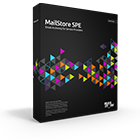Difference between revisions of "Frequently Asked Questions"
| [unchecked revision] | [unchecked revision] |
| Line 1: | Line 1: | ||
| − | = System Requirements = | + | == System Requirements == |
* '''What are the system requirements of MailStore Service Provider Edition?'''<br/>A comprehensive overview of all system requirements can be found on the [[System Requirements]] page. | * '''What are the system requirements of MailStore Service Provider Edition?'''<br/>A comprehensive overview of all system requirements can be found on the [[System Requirements]] page. | ||
* '''What are the recommendations for a persistent, high performance operation?'''<br/>Such recommendations are available in our [[Performance and Scalability Guidelines]]. | * '''What are the recommendations for a persistent, high performance operation?'''<br/>Such recommendations are available in our [[Performance and Scalability Guidelines]]. | ||
| Line 6: | Line 6: | ||
* '''Will there be a Linux version?'''<br/>Due to being fully dependent on Microsoft’s .NET Framework, it is unlikely that a Linux version will exist in the future. | * '''Will there be a Linux version?'''<br/>Due to being fully dependent on Microsoft’s .NET Framework, it is unlikely that a Linux version will exist in the future. | ||
| − | = Use Scenarios = | + | == Use Scenarios == |
| − | |||
* '''How can I switch from single server to multi server mode?'''<br/>Any single server mode setup where Management Server, Instance Host and Client Access Server roles are installed on the same server, can be turned easily into a multi server mode setup by adding additional Instance Hosts or Client Access Servers. Further information can be found in the [[Multi Server Mode Setup]] chapter. | * '''How can I switch from single server to multi server mode?'''<br/>Any single server mode setup where Management Server, Instance Host and Client Access Server roles are installed on the same server, can be turned easily into a multi server mode setup by adding additional Instance Hosts or Client Access Servers. Further information can be found in the [[Multi Server Mode Setup]] chapter. | ||
* '''As a large organization (end customer), can I run MailStore Service Provider Edition in my own Private Cloud?'''<br/>Generally, the MailStore Service Provider Edition can be used in Private Clouds. Please [https://cs.mailstore.com contact us] for further details. | * '''As a large organization (end customer), can I run MailStore Service Provider Edition in my own Private Cloud?'''<br/>Generally, the MailStore Service Provider Edition can be used in Private Clouds. Please [https://cs.mailstore.com contact us] for further details. | ||
* '''As a Service Provider, can I use MailStore Service Provider Edition in Virtual Private Clouds that I am hosting for my end customers?'''<br/>Using MailStore Service Provider Edition in Virtual Private Clouds is absolutely possible. Please refer to the [[Overview]] to learn more about the different supported scenarios. | * '''As a Service Provider, can I use MailStore Service Provider Edition in Virtual Private Clouds that I am hosting for my end customers?'''<br/>Using MailStore Service Provider Edition in Virtual Private Clouds is absolutely possible. Please refer to the [[Overview]] to learn more about the different supported scenarios. | ||
* ''' Can MailStore Service Provider Edition run on Amazon EC2, Windows Azure or similar infrastructure?'''<br/>Due to its storage technology and the required disk I/O throughput, it is not recommended to run MailStore Service Provider Edition on such infrastructure. | * ''' Can MailStore Service Provider Edition run on Amazon EC2, Windows Azure or similar infrastructure?'''<br/>Due to its storage technology and the required disk I/O throughput, it is not recommended to run MailStore Service Provider Edition on such infrastructure. | ||
Revision as of 10:34, 1 July 2014
System Requirements
- What are the system requirements of MailStore Service Provider Edition?
A comprehensive overview of all system requirements can be found on the System Requirements page. - What are the recommendations for a persistent, high performance operation?
Such recommendations are available in our Performance and Scalability Guidelines. - What is the maximum number of user archives per instance?
The maximum recommended number of users per instance is 300. For further details, refer to our Performance and Scalability Guidelines. - What is the maximum number of instances (respectively end-customers) that can be created?
An infinite number of instances can be deployed on an unlimited number of Instance Hosts. Please refer to our Performance and Scalability Guidelines or contact our technical support directly for further inquiries. - Will there be a Linux version?
Due to being fully dependent on Microsoft’s .NET Framework, it is unlikely that a Linux version will exist in the future.
Use Scenarios
- How can I switch from single server to multi server mode?
Any single server mode setup where Management Server, Instance Host and Client Access Server roles are installed on the same server, can be turned easily into a multi server mode setup by adding additional Instance Hosts or Client Access Servers. Further information can be found in the Multi Server Mode Setup chapter. - As a large organization (end customer), can I run MailStore Service Provider Edition in my own Private Cloud?
Generally, the MailStore Service Provider Edition can be used in Private Clouds. Please contact us for further details. - As a Service Provider, can I use MailStore Service Provider Edition in Virtual Private Clouds that I am hosting for my end customers?
Using MailStore Service Provider Edition in Virtual Private Clouds is absolutely possible. Please refer to the Overview to learn more about the different supported scenarios. - Can MailStore Service Provider Edition run on Amazon EC2, Windows Azure or similar infrastructure?
Due to its storage technology and the required disk I/O throughput, it is not recommended to run MailStore Service Provider Edition on such infrastructure.
